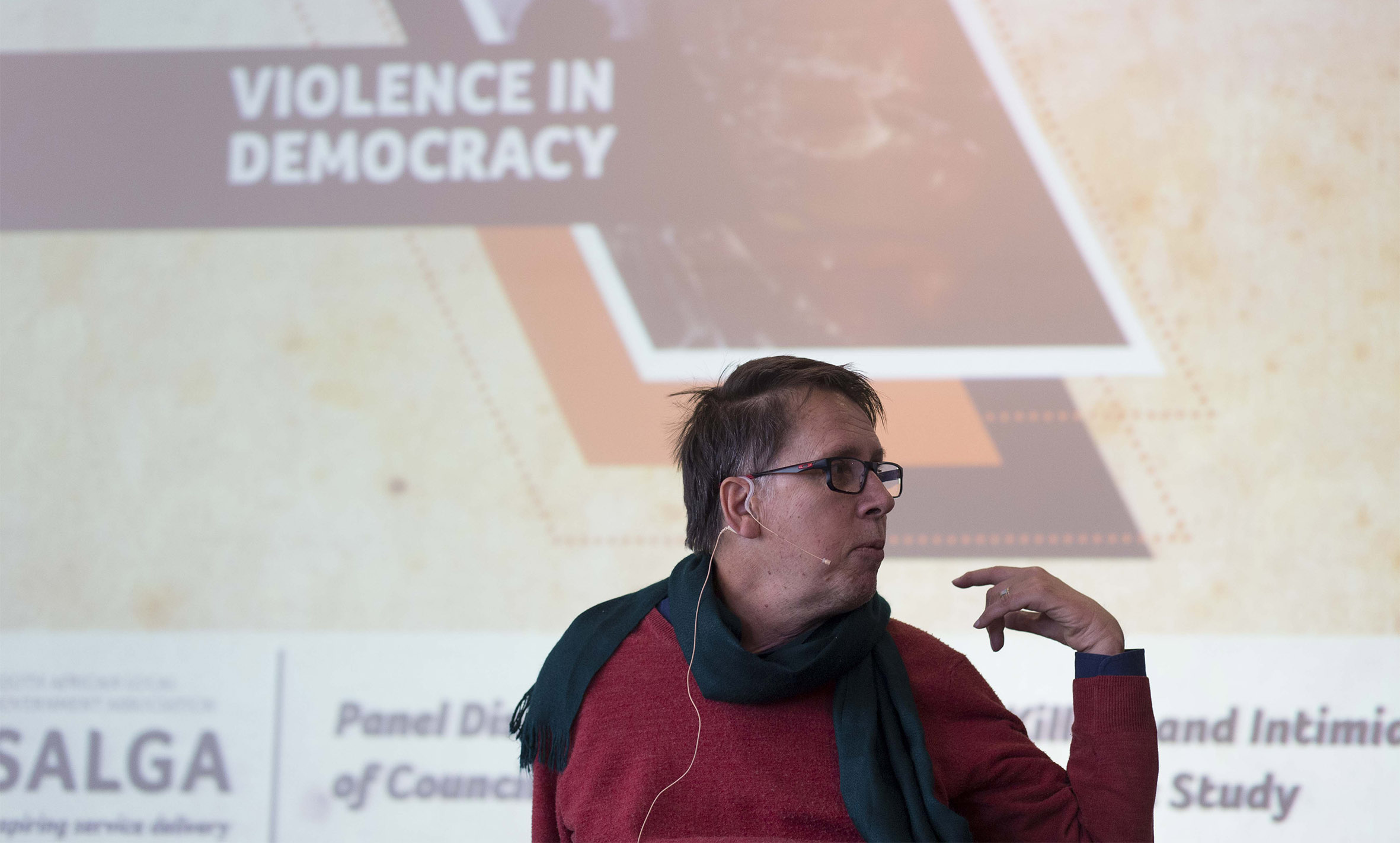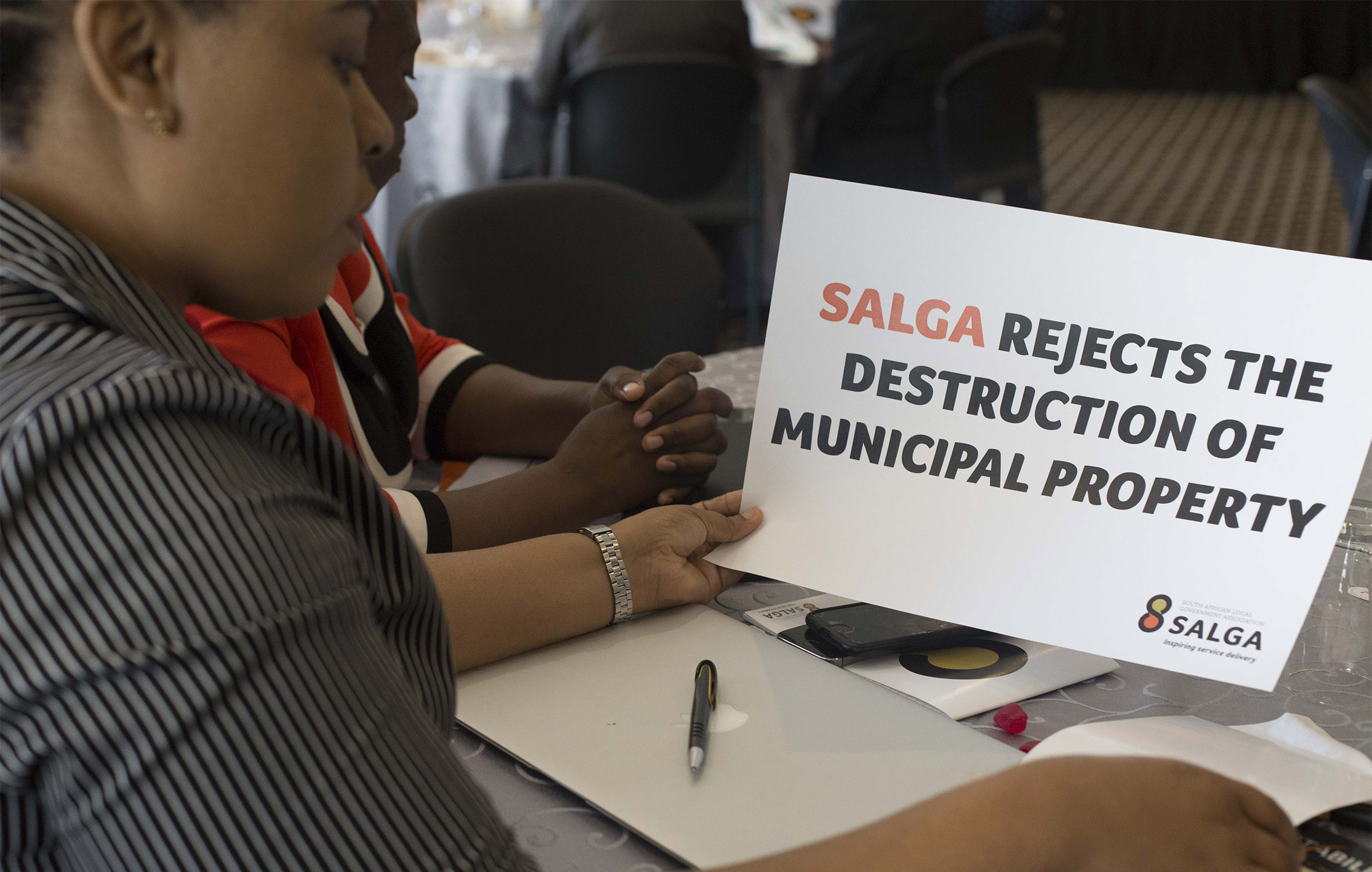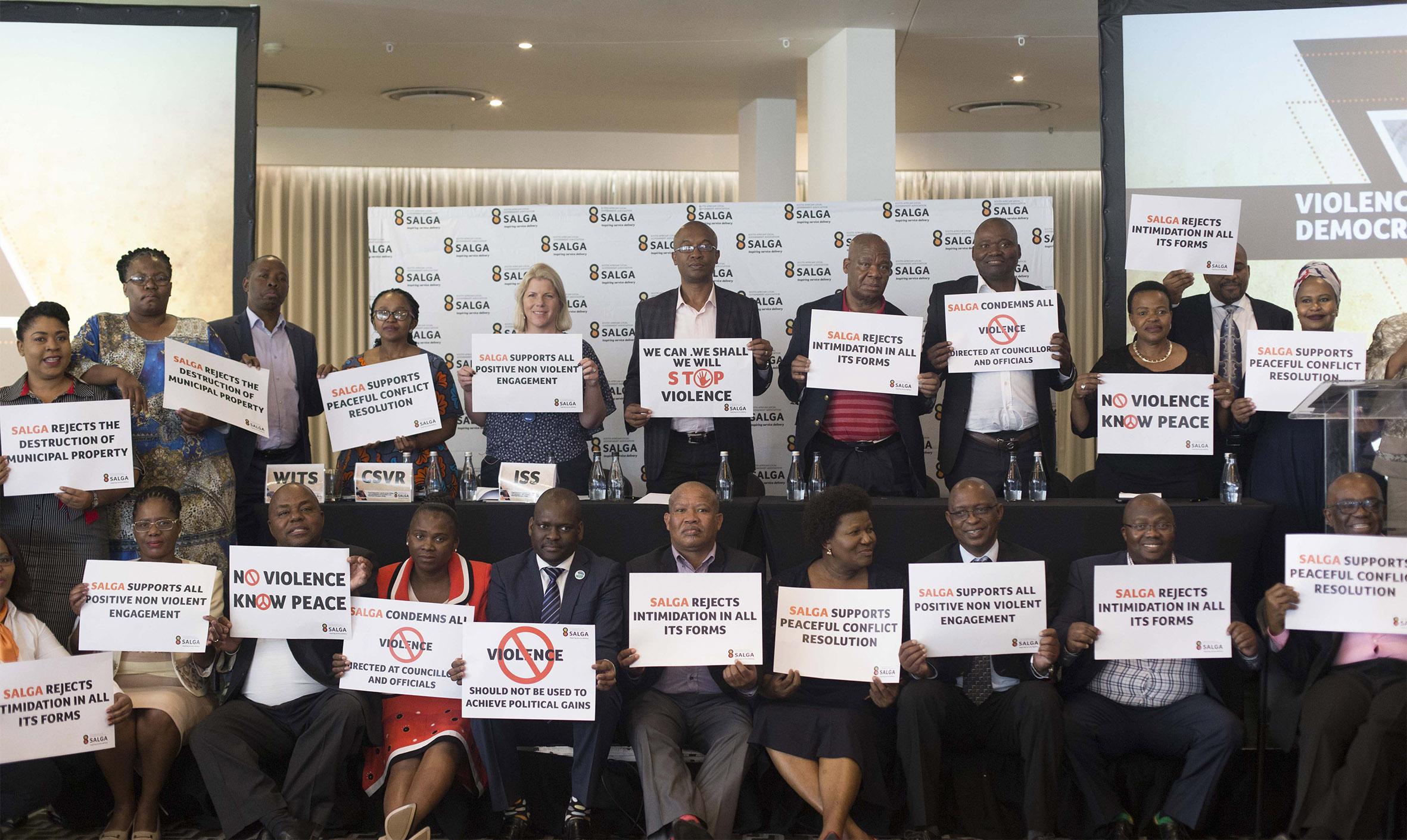Amos Masondo Member of Parliament
The high stakes in democracy, and the competition for power and access to resources are increasingly contributing to the hike in violence across the country. This was the concern raised during the panel debate at the recent launch of the South African Local Government Association’s (SALGA) report on the intimidation and killing of councillors and municipal managers titled Violence in Democracy. Panelists argued that a multi-sectoral strategy to fight crime was urgently needed. However the fight against violence and intimidation cannot be successful if the historic nature of the violence is not understood, and if the institutions responsible for fighting crime are implicated in the factional battles that exacerbate the violence.

Professor Karl von Holdt, director of the Society, Work and Development Institute at the University of the Witwatersrand, argues that South Africa is a violent democracy, with violence not dissimilar to that experienced in other democracies globally, where factions battle for control and power in the state. He attributes this to an informal system in our democracy that emerged alongside the formal democratic political system of 1994. This informal system is characterised by patronage and factionalism, which inter alia accounts for the assassination and intimidation of publicly elected officials. Violence is associated with processes of democracy such as elections. This violence includes not only the terrorising of individuals and the destruction of their property, but there are other forms of violence connected to democracy that speak to the systemic nature of this crisis.
Von Holdt made reference to collective violence in party structures, citing the recent ANC Eastern Cape conference where delegates were injured after delegates threw chairs at each other. Institutions such as the South African Police Service (SAPS) and the National Prosecuting Authority (NPA) are seen to protect some individuals and organisations instead of prosecuting them. In addition they are selectively prosecuting those suspected for wrongdoing. This creates the perception that those who are behind the violence can in fact get away with it — for the right price.
Competition for access to resources
The distinct architecture of violence in South Africa is underpinned by fierce struggle and competition for access to resources. Executive director of the Centre for the Study of Violence and Reconciliation (CSVR), Nomfundo Mogapi, highlighted the importance of not forgetting that our society is fractured as a result of our history and prevailing unfavourable economic conditions. The more desperate people are for economic opportunities, employment and resources, the more violence there is. Even as more resources are spent in the fight against crime, the violence continues to increase. Mogapi believes that allocating resources to fight crime alone will not address the crisis; the answer lies in exemplary and ethical leadership. “South Africa has wounded leaders who have become a part of the problem,” she said. She argued that a holistic approach to address these aspects will result in “service delivery being a final product of a healthy system”, and that addressing violence should be an integral part of service delivery itself.

A member of the audience examines a poster launched on Violence in Democracy.
Are unfair expectations upon councillors a cause of the violence and intimidation they experience from community members? The president of SALGA, Cllr Parks Tau, believes so. He bemoaned the fact that councillors are at times expected to mediate on behalf of entities of the state or account for issues falling outside their scope of responsibility. This places their lives and that of immediate family as well as their properties at risk, because people take out their anger on councillors when it is in fact other entities that ought to take responsibility. He emphasised that communities must be educated of the role of councillors in order to prevent incidents of misdirected blame and their resultant violence.
The killing and intimidation of councillors has also seen female councillors being frequently targeted as they are seen as easy targets. The recent intimidation of the mayor of Polokwane Municipality, Cllr Thembi Nkadimeng, was cited as an example of a female councillor being targeted. Women are already vulnerable in societies with high levels of violence. Inadequate support from the state for councillors exacerbates this risk. Chairperson of the SALGA Women’s Commission, Cllr Sindiswa Gomba said that the gender issue merits greater attention than what is currently being afforded. In 2016 several of the cases reported were those of female councillors who were killed. The mayor of Emalahleni, Cllr Lindiwe Ntshalintshali, who was recently in the news for “excessive” spending for security, spoke about how she has been threatened in her municipality and stressed the need for protection, because the lives of councillors are often in danger. Chairperson of the SALGA Working Group responsible for Councillor Welfare, Cllr Bheki Stofile, mentioned this case as another example of the perception created in the public that councillors are corrupt, when in fact they are in need of protection. He called for a change in the public narrative about councillors, and urged the prioritisation of cases of violence against councillors to deter those who may have criminal intentions.
Sources of councillor attacks
There were some disagreements regarding the nature of the killings, and whether in fact these killings are political. Mayor of Umvoti municipality Cllr Thami Ngubane said that it is important to ask the right questions, and challenged the panel by suggesting that inter-party killings were not only political, but may also result from other reasons such as greed. Intra-party political violence is disproved by the findings from SALGA’s study, however it confirms intra-party killings and intimidation of councillors. An analysis into some of the deaths of councillors shows that at times the source of the threats is from within the party of the deceased councillors. Party lists, tenderpreneurs and political opponents were cited as some of the other reasons for councillors being killed and intimidated.
Recommendations that emerged from the panel discussion included that platforms should be created for councillors to engage better with communities, so that community members are clear about what councillors are responsible for. Secondly, there is a need for leadership to transform municipal institutions and ensure they function optimally to achieve law and justice. Manager at the Institute for Security Studies, Lizette Lancaster, stressed that in as much the reported killings are concentrated in KwaZulu-Natal province, attacks that take place all over the country are important to examine and understand. She called for all forms of intimidation to be included as violence, because these can lead to killings. Police need to be trained better to deal with cases, and other state institutions need to be of assistance in the investigation and prosecution of those responsible for these crimes. The messaging around violence is critical as it indicates how seriously the issue is being taken. Local, provincial and national government need to get on top of issues and implement effective conflict resolution to put an end to the high levels of violence, said Lancaster.
Part 1: SALGA Report: Violence in Democracy
SALGA conducted a study to determine the extent of violence and intimidation against councillors and municipal managers as a result of growing concerns across the country. A sample of 54 councillors and 40 municipal managers from across the country was engaged. While the sample was relatively small, it can be extrapolated to demonstrate national trends. The systemic violence has involved the destruction of municipal property during protests, damage to private property, threats towards individual and loss of life. The source of the threats is community members, members of their own political parties and threats from opposition political parties. This trend has threatened to derail service delivery progress in various municipalities and has contributed to the fragility of local government. The study sought to understand the extent to which councillors have experienced violence, and what needs to be done to protect and assist councillors in the fulfillment of their duties.
Councillors and municipal managers responded to survey questions and expressed their opinions on personal experiences of intimidation as well as property destruction and violence. They further shared and observed experiences of their peers, whether action was taken when cases were reported, perceptions and knowledge of who was responsible for the threats and their views on potential remedial action to be taken.
The gender bias in councillor attacks
The study found that of the 66% of the councillors reported that they had been threatened at least once and 46% reported being threatened frequently. Male councillors were threatened with physical violence more often than female councillors. For women who had been threatened, the threats were directed to their families, and sometimes they were threatened with rape. The threats were also skewed towards speakers and chief whips of councils, more than they were towards ward and proportional representatives. When asked about how the threats of violence had influenced their likelihood to make themselves available for another term, 55% of the councillors said that the threats made them less willing to run another term. 66% said the violence and threats of violence had negatively affected their performance. This has led to a worrying trend of councillors resigning and choosing to not complete their terms of office. Only 27% of the respondents felt that the threats were not significant enough to deter them from public service.

Delegates make a stand against violence against councillors and municipal managers
For municipal managers, 60% reported that they had been threatened, and 30% reported that they had been threatened frequently. In 30% of the cases of intimidation that were reported to authorities or to political parties, the threats stopped. In 12.5% of reported cases, restraining orders were obtained, which stopped the threats and intimidation. Municipal managers reported that the motivation for the threats and violence were economic reasons such as tender awards, employment and salaries or wages. Municipal managers face different challenges to councillors because of limited interface with community members. Working with organised labour poses an additional risk as issues around resource management exposed municipal managers to threats, particularly in instances of theft, irregular allocation of municipal funds and the awarding of tenders.
A trend that has emerged as a result of the violence and other factors is that of municipal managers not completing their contract periods, serving an average of three years of their five-year contracts. The loss of skills and experience has an immense impact on service delivery and continuity in municipalities; municipal managers are highly skilled administrators, with 60% of whom have master’s and PhD levels of education. It is local government’s service delivery programmes that suffer due to managers being killed or leaving their jobs before their tenure ends.
The study found that the three dominant ways councillors are killed is while they are in transit, upon entering their homes and kidnapping. Kidnapping is said to be common in municipal wards that are contested and won by opposition parties. Other forms of killings are opportunistic, where councillors are gunned down while walking in the street, or targeted while attending a political meeting.
Security risk assessment
To curb the effects of intimidation and violence, SALGA has undertaken initiatives to support its members. One of those initiatives is the advocacy for Special Risk Insurance (Sasria), in which municipalities take out risk cover for councillors against the loss or damage to property caused by civil unrest. The study reveals that whilst municipalities are not compelled to take out Sasria cover for their own property they must take this cover for councillors. When the SAPS regard a threat as credible, municipal managers are authorised to detail security for councillors. What is important is that SAPS conducts assessments timeously, in order for security to be authorised, which does not happen often enough, thus risking the lives of councillors.
The protection services available at local government level is vastly different from the protection services afforded to political officials at provincial and national level. At national level the SAPS conducts assessments, and in conjunction with the departments of transport and public works, upgrades are done in accordance with the assessment. Due to funding constraints and public outcry these similar upgrades for councillors are not extended to councillors. It is only in the event of a threat deemed credible by the SAPS that council is obliged to provide protection for the public representatives and their families.
The study revealed that a significant number of councillors are unaware of the measures put in place by SALGA to protect them or support them when they are under threat. In the SALGA Working Group on councillor welfare, councillors expressed the fear that the security supplied by the council — where a threat has been identified — was often known to rival political group supporters. They felt that this type of security assigned to them was ceremonial rather than a deterrent to would be attackers.

Xolile Goerge, SALGA chief executive, presents the study on Violence in Democracy.
SALGA recommendations
In order for South Africa to deal with the scourge of violence, the study recommends that existing security arrangements be improved — better forms of security must be made available as and when they are needed. The SAPS must improve their security assessments of councillors’ properties timeously to prevent the intensification of threats after they are initially reported. A safety and security manual for councillors and municipal managers must be developed, outlining steps to be taken in the event of threat or harm.
The study also recommends that cases of killings and intimidation of councillors be considered and treated as priority crimes that are investigated without fear or favour, regardless of the political parties involved. The psychological impact on those at the receiving end of threats should be taken more seriously, and trauma counselling facilities be made available to assist. Councillors should be empowered with conflict resolution skills to better deal with issues when they arise. Data literacy can assist them in understanding their constituencies in order for them to respond to the needs of people effectively. The study also calls for greater collaboration with civil society and community-based organisations where possible to assist in information and intelligence gathering.
A culture of impunity or the protection of those responsible for political killings of councillors and municipal managers is implied by the ineffectiveness of the justice system in the prosecution of murders in general. The crisis is systemic, and is reflected in how the few cases of murders of councillors have been successfully prosecuted. This suggests that South Africa is not dealing effectively with this scourge, which is deeply embedded in the South African society.